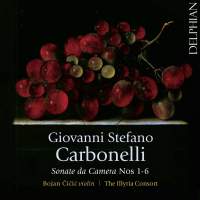Texte paru dans: / Appeared in: |
|
|
Outil de traduction ~ (Très approximatif) |
|
|
Reviewer: Barry
Brenesal Giovanni Stefano Carbonelli (1694–1773) was one of many 17th-century composer-violinists from the Italian States who chose to seek their fortunes abroad. While some ended up in the German-speaking courts that turned to the Holy Roman Emperors in Vienna for their artistic values, others settled into England’s large Italian immigrant population. Geminiani was the most celebrated of these, but Carbonelli quickly achieved a degree of prominence as well. We know that he was giving public concerts in London in 1719, and that same year was appointed leader of the orchestra at the Drury Lane Theatre. John Manners, Third Duke of Rutland, financed the publication of his sole surviving work, his Sonate da camera, though Carbonelli also composed concertos. In the 1730s Carbonelli started composing and performing less. He underwent a gradual change in profession, taking up the career of vintner. This advanced him socially and financially—so much so that in 1759 he became official purveyor of wines to King George II and his court. His inventory at death included two Stainer violins and a Stradivarius, though surviving notices of the day only make mention of his second career, not his first. Carbonelli’s sonata collection of 12 violin sonatas divides between its first six, which for the most part include fugal second movements, with a second six that feature dance movements instead. Corelli’s preference for four-movement sonatas is generally adhered to, though there are two with three movements, and one with five. The music is inventive, but also structurally resourceful; Carbonelli includes several tripartite movements, and ends each group of six sonatas with a large-scale series of variations that successfully builds tension and technical complexity over its lengthy span. These sonatas appear to have been reasonably popular, for 18 copies of John Walsh’s republication survive today in public collections. The Illyria Consort was formed by violinist Bojan Čičić to perform rarely heard 17th- and 18th-century scores. Čičić himself is a distinguished violinist with an attractive tone and a flair for proper ornamentation. He employs vibrato to excellent effect in lyrical passages, but seldom elsewhere; his straight tone in the sober, moderately paced fugue of the Fourth Sonata gives the piece a proper gravitas without any loss of beauty. Just occasionally he sounds pressed to the edge of his technique in one of the more formidably agile movements, such as the tripartite opening to the Sixth Sonata, where the figurations sit not quite with full security under his hand. Aside from that, his performances are poised and informed, as are those of the rest of the members in his ensemble. The sound, too, is adroit, with just enough ambient echo to bring out the quality of the instruments, rather than obscuring them.
In short,
strongly recommended, with hopes that Čičić and Delphian will release a
recording of the second set of six sonatas in the near future.
| |
|
|
|
|
Cliquez l'un ou l'autre
bouton pour découvrir bien d'autres critiques de CD |
|




